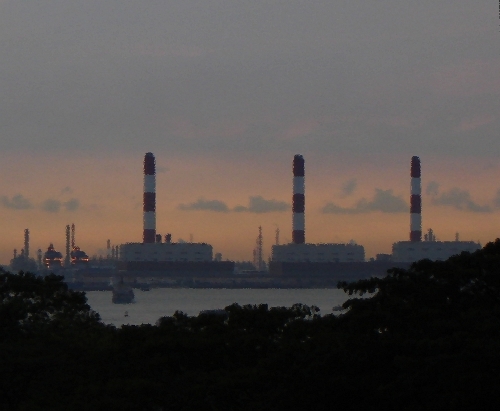

Maybe I should do a series of photos like this illustrating different light conditions, a bit like Monet's paintings of the Rouen Cathedral.
August 11, 2010
I posted "week300", the last
issue of This Week's Finds in Mathematical Physics. It made me kind of
sad. But it's full of cool stuff, including two papers I'll need to finish
sometime, one with James Dolan and one with Todd Trimble.
August 15, 2010
Lisa's colleague Grace Fong came to a conference and stayed in the
guest house at NUS. On Sunday we all went to the botanical garden.
One of the first things that struck me were the banyan trees.
Here is a Ficus kurzii, or Burmese banyan:

Lots of interesting leaves:





Some interesting flowers:



Busy taking pictures, I fell behind Lisa and Grace as we walked through a patch of jungle:


Lisa took lots of pictures too:

Eventually we reached the orchid garden:






It was hot and steamy throughout the botanical garden... until we reached the "Cool Room", a glassed-in garden that was kept at a lower temperature and regularly sprayed with chilly fog. It was full of carnivorous plants, like pitcher plants:





... and sundews and Venus flytraps:

Leaving the garden, we saw some huge trees:
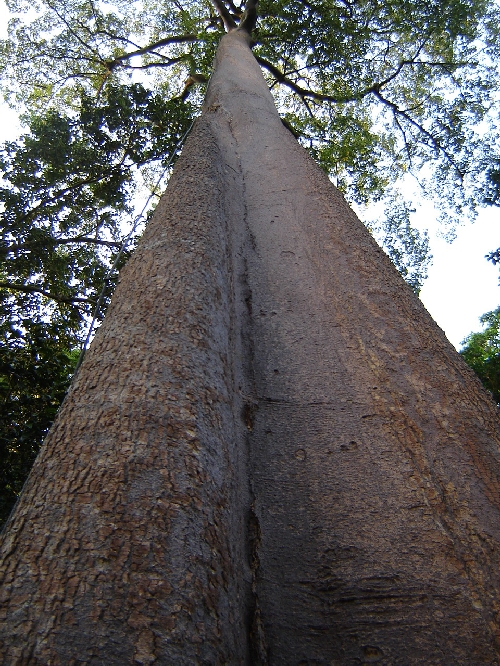
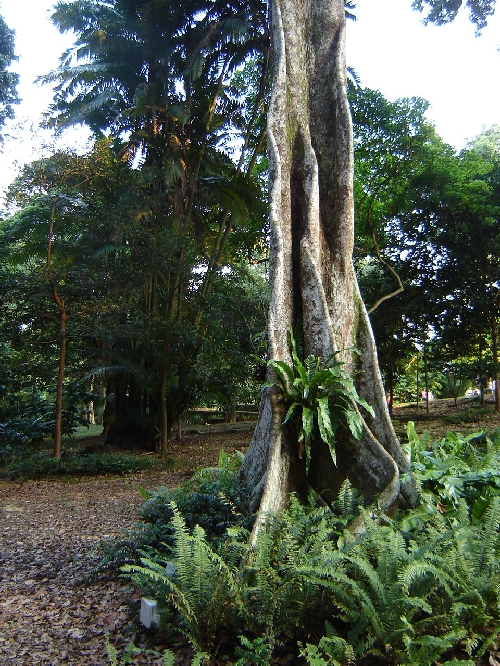
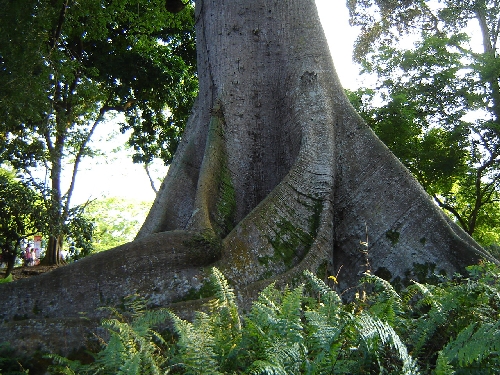
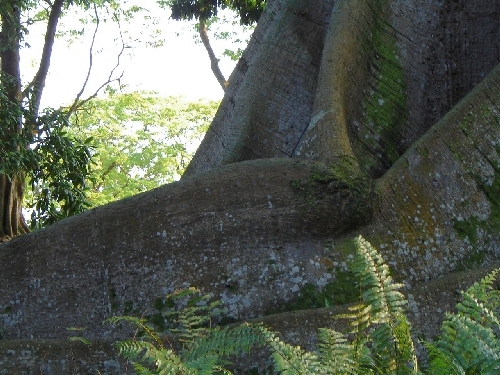
I believe the tree in the last two photos is a kapok tree, Ceiba pentandra, that was planted in
1933.
August 18, 2010
I decided it's time to start a kind of seminar or research group
focused on diagrammatic methods for studying open systems — the
kind of stuff I began discussing back in week292 - week297. So, I
talked to Jake Biamonte and Dieter
Jaksch and Stephen R. Clark, all
folks from Oxford who regularly visit the CQT.
Jake is already into the general idea of using category theory to clarify and unify diagrammatic methods, not just for quantum systems but also things like electrical circuits. On the other hand, Dieter and Stephen are using diagrammatic methods for more specific practical purposes: for example, describing "tensor states" of quantum systems like the Hubbard model, which can be nicely simulated using optical lattices. I'm less familiar with this stuff, but it sounds cool, so I want to study it. Dieter recommended these papers:
The new Pentagon report, "Military and Security Developments Involving the People's Republic of China," suggests China wants to establish itself as a dominant regional power before claiming a larger global role. The Chinese military, according to the Pentagon, is pursuing "anti access and area denial strategies" in its corner of the world with respect to potential rivals like Japan, South Korea and the United States. In part, this means being prepared to keep U.S. and other foreign military forces as far from Chinese waters as possible."One of the missions that have been given to the Chinese Navy and the Chinese air force has been to extend China's defensive perimeter out to sea, eastward," says [David] Finkelstein, now at the Center for Naval Analyses. "So they're developing operational capabilities that can make it difficult for forces outside the region to operate with impunity inside China's coastal strategic areas."
New Chinese submarines, according to the Pentagon report, are being equipped with missiles capable of destroying aircraft carriers operating anywhere in the Western Pacific. At the same time, China is locking up oil supplies and other resources needed to fuel its economic growth, looking especially to nearby countries like Iran and Afghanistan.
"They do intend to become very dominant in the region," says Cornell's Prasad, formerly the top China specialist at the International Monetary Fund. "They see economic, political and military issues as all intertwined in terms of trying to obtain their longer-term objectives."
International law normally recognizes a country's territorial domain only over seawaters within 12 miles of its shores, but China is claiming dominion out to 300 miles. Other Asian countries, with U.S. support, are now pushing back, as was evidenced at a meeting last month of the Association of Southeast Asian Nations in Hanoi. But China has not retreated, with Chinese leaders even asserting their domination of the Yellow Sea, between China and the Korean Peninsula.
"Beijing's statements about their sovereignty in the Yellow Sea as well as their sovereignty in the southern part of the China Sea reflect a new, even more expanded view [of their sovereignty claims]," says James Mulvenon of the Defense Group consultancy. He notes that the United States has repeatedly challenged China's claims, most recently in the speech given by Secretary of State Hillary Clinton at the ASEAN meeting in Hanoi.
"We have been very clear in the last three or four months to say that we reject that [Chinese] definition of sovereignty and that we are going to deliberately reassert our ability to operate freely in those areas," Mulvenon says.
Such statements, in the face of Chinese claims, suggest that if there is to be a U.S.-China military conflict in the coming years, it most likely would be a naval confrontation in some part of the China Sea.
China, meanwhile, is also boosting its military presence in distant corners of the globe. The Pentagon report highlighted the role of the Chinese navy in anti-piracy operations off the coast of Somalia and China's direction last year of a military medical exercise in the African nation of Gabon. Such relatively minor moves serve at least to bolster China's international image as a military player.
"They're going to be out there showing the flag in the Horn of Africa, Indian Ocean and other places," Finkelstein says. "We're going to have to get used to that."
It would be a mistake to conclude China will rule the world anytime soon. It still has huge internal challenges to deal with, including widespread rural poverty and an unbalanced economy that depends far too much on other countries continuing to buy Chinese goods. Twenty years ago, many commentators were predicting the next global superpower would be Japan, the very country that has now slipped to No. 3 in the economic rankings.
But China's military and economic development over the past decade has been dramatic, and at this point it seems destined to be a dominant 21st century player.
August 27, 2010
Today I posted "week301", the first
issue of the new series of This Week's Finds. It took me forever to get
the tone right, and decide what to include. A far cry from
"week1", which I just spat out
thoughtlessly. I guess I'm getting old, taking myself too seriously.
But anyway, it's fun to be starting a new project.
August 30, 2010
I recently heard how the Koch brothers are funding a wide variety of
groups who are trying to block action on climate change. Never heard
of the Koch
brothers? They run the 2nd largest privately held company in the
US, with revenues of almost $100 billion. They do a lot of oil
refining. And they contribute lots of money to climate change denial
groups: organizations whose goal is to prevent action on global
warming. According to Greenpeace, "From 2005 to 2008, ExxonMobil
spent $8.9 million while the Koch Industries-controlled foundations
contributed $24.9 million in funding to organizations of the "climate
denial machine"."
I think it's good to find out who is in the pay of these foundations, so we can improve our understanding of who is honestly seeking the truth and who is arguing for commercial interests.
From the executive summary of the Greenpeace report:
For years, both openly and behind the scenes, ExxonMobil dominated the voice of climate science denial in the national global warming dialogue. However, after a decade of reputation-damaging public disclosures, as well as pressure from scientific organizations, shareholders and senators, ExxonMobil implemented a new public relations strategy under a new CEO, and has begun to moderate its public statements on climate change. ExxonMobil's website declares: "We have discontinued contributions to several public policy research groups whose position on climate change diverted attention from the important discussion on how the world will secure the energy required for economic growth in an environmentally responsible manner".In spite of publishing this statement and reducing funding to a number of prominent climate denial organizations over the past few years, ExxonMobil continues to support dozens of organizations who are part of the climate denial movement with millions of dollars in annual funding. ExxonMobil has responded to public scrutiny by slightly reducing their support of climate denial, and Koch Industries is outpacing ExxonMobil's funding activities while drawing very little public attention. As ExxonMobil's silent partner in funding the climate-denial machine, Koch Industries often uses similar and sometimes more aggressive tactics.
Kansas-based Koch Industries is a conglomerate dominated by petroleum and chemical interests with approximately $100 billion in annual sales, operations in nearly 60 countries and 70,000 employees. Most of Koch's operations are invisible to the public, with the exception of a handful of retail brands such as Brawny® paper towels and Dixie® cups, produced by its subsidiary Georgia-Pacific Corporation. Koch Industries has been ranked as the first- or second-largest privately-held company in the United States in recent years, currently ranked second behind Cargill corporation.
Two brothers, Charles and David Koch, each own 42 percent of the company. Part of Koch Industries. influence is channeled through three foundations, also controlled by the two brothers. This report documents roughly 40 climate denial and opposition organizations receiving Koch foundation grants in recent years, including:
- More than $5 million to Americans for Prosperity Foundation (AFP) for its nationwide "Hot Air Tour" campaign to spreading misinformation about climate science and opposing clean energy and climate legislation.
- More than $1 million to the Heritage Foundation, a mainstay of misinformation on climate and environmental policy issues.
- Over $1 million to the Cato Institute [founded by one of the Koch brothers], which disputes the scientific evidence behind global warming, questions the rationale for taking climate action, and has been heavily involved in spinning the recent ClimateGate story.
- $800,000 to the Manhattan Institute, which has hosted Bjorn Lomborg twice in the last two years. Lomborg is a prominent media spokesperson who challenges and attacks policy measures to address climate change.
- $365,000 to Foundation for Research on Economics and the Environment (FREE) which advocates against taking action on climate change because warming is "inevitable" and expensive to address.
- $360,000 to Pacific Research Institute for Public Policy (PRI) which supported and funded An Inconvenient Truth... or Convenient Fiction, a film attacking the science of global warming and intended as a rebuttal to former Vice-President Al Gore's documentary. PRI also threatened to sue the US Government for listing the polar bear as an endangered species.
- $325,000 to the Tax Foundation, which issued a misleading study on the costs of proposed climate legislation.
This is only part of the picture, because the full scope of direct contributions to organizations is not disclosed by individual Koch family members, executives, or from the company itself. Contributions through Koch's political action committee (PAC) are a matter of public record. Since the beginning of the 2006 election cycle, Koch's PAC spent more on contributions to federal candidates than any other oil-and-gas sector PAC. For that period, Koch Industries and its executives spent $2.51 million compared to next three biggest contributors: Exxon ($1.71 million), Valero ($1.68 million), and Chevron ($1.22 million).

Check out some color photos taken by Sergei Mikhailovich Prokudin-Gorskii from 1909 to 1912, long before modern-day color photography was invented:
His trick: take three black and white photographs through red, green and blue filters.
© 2010 John Baez
baez@math.removethis.ucr.andthis.edu